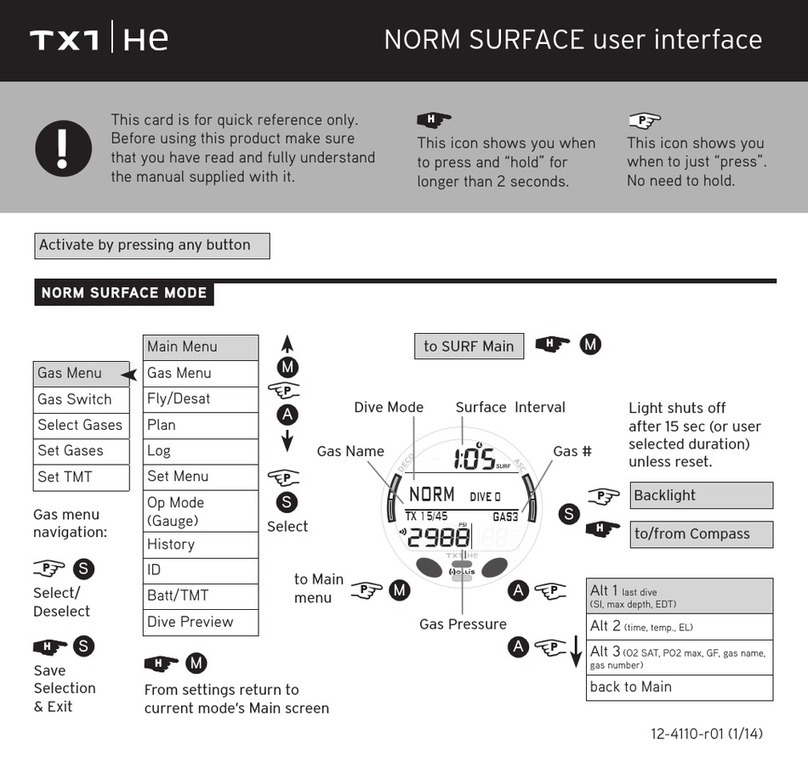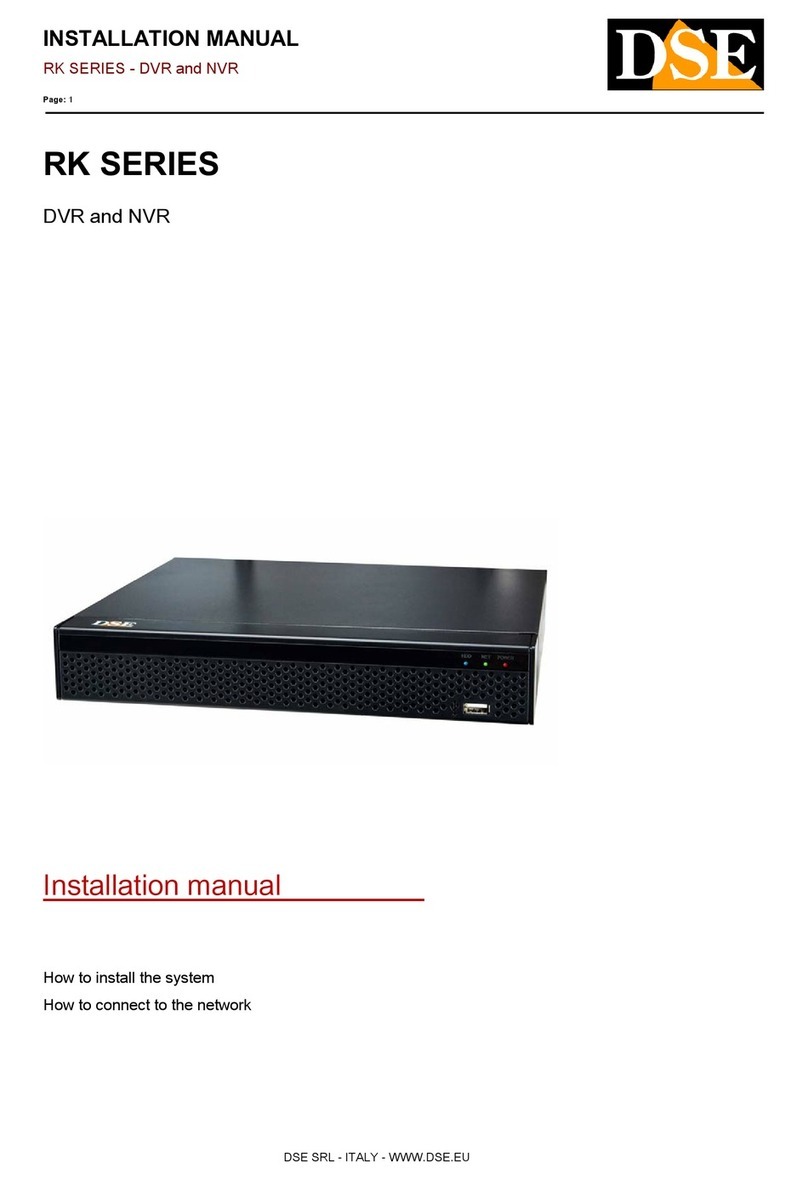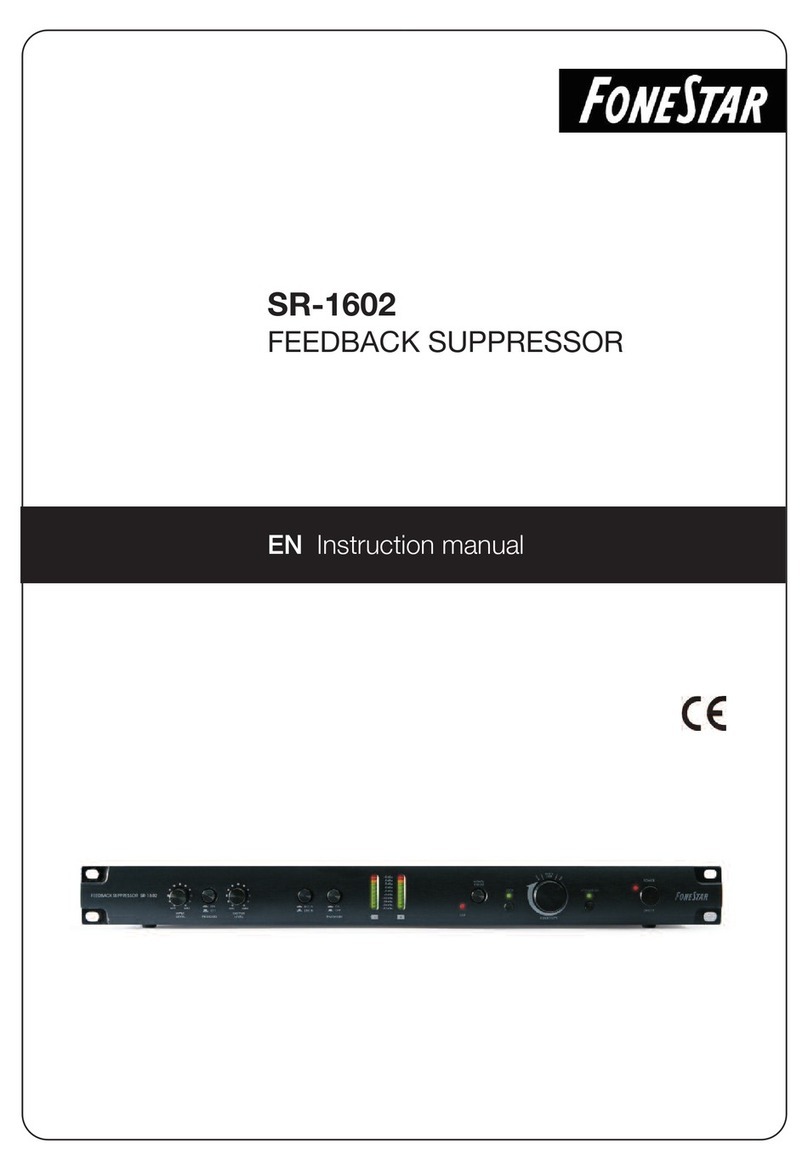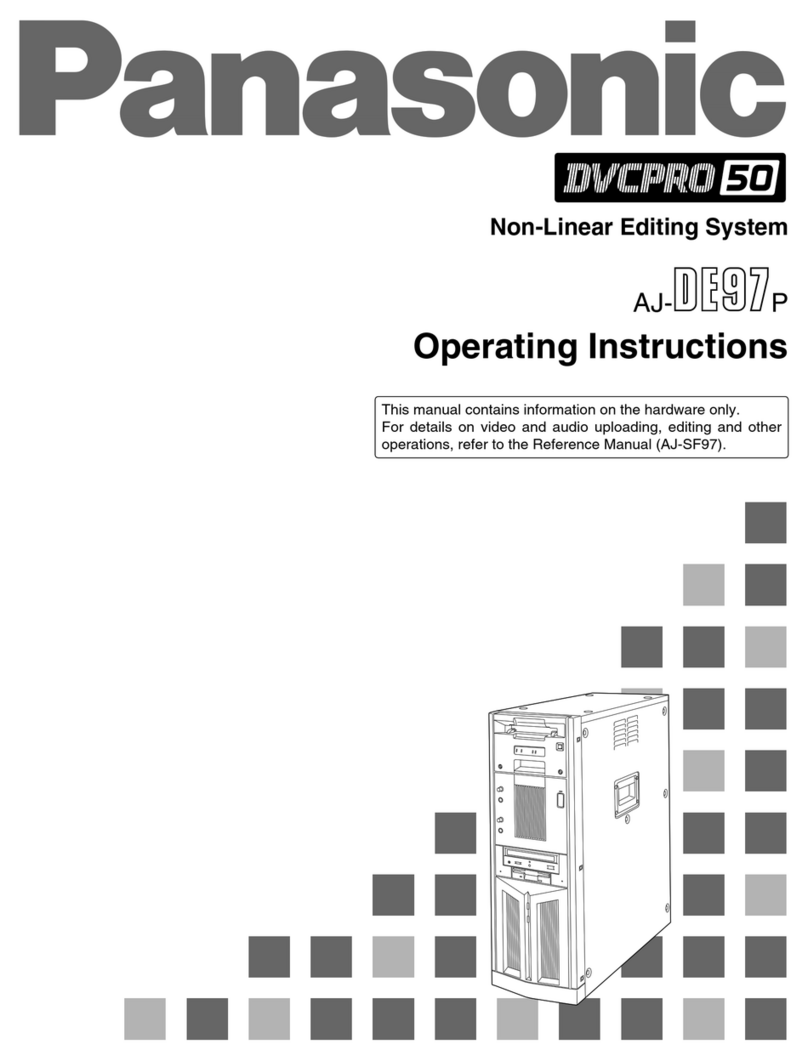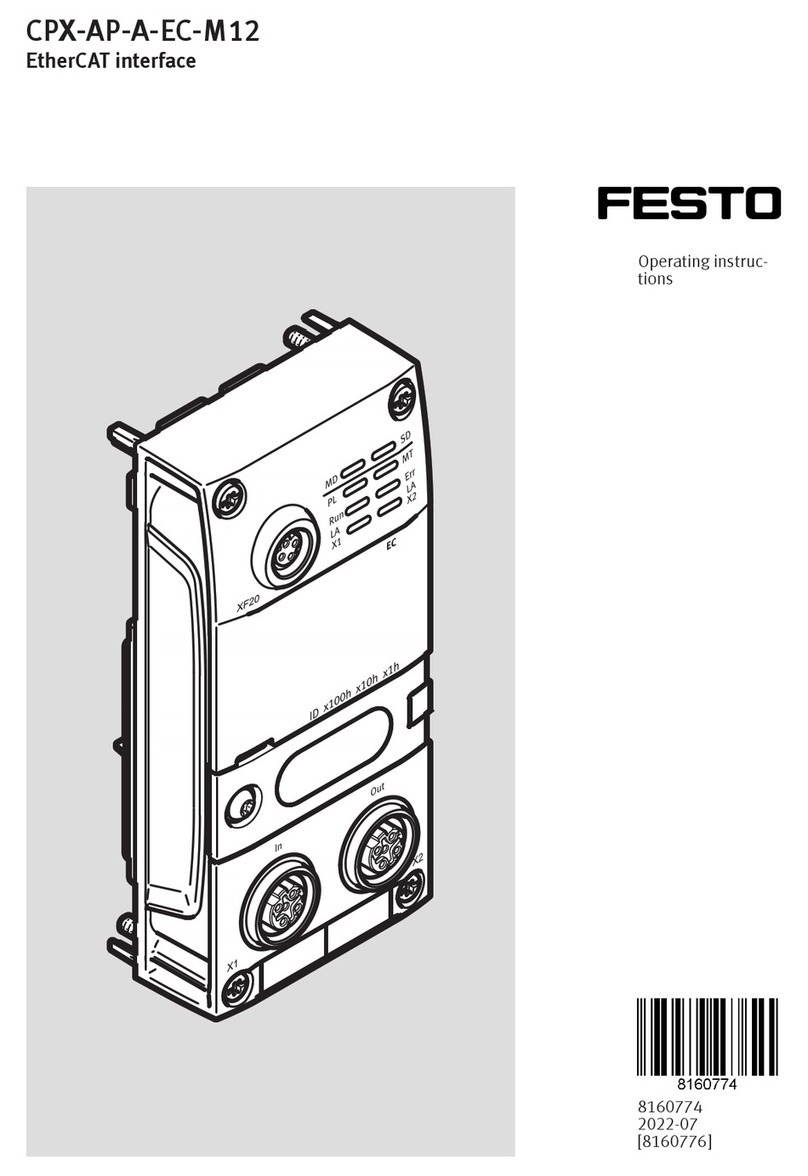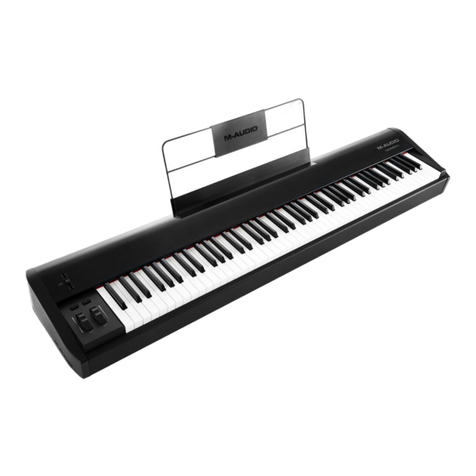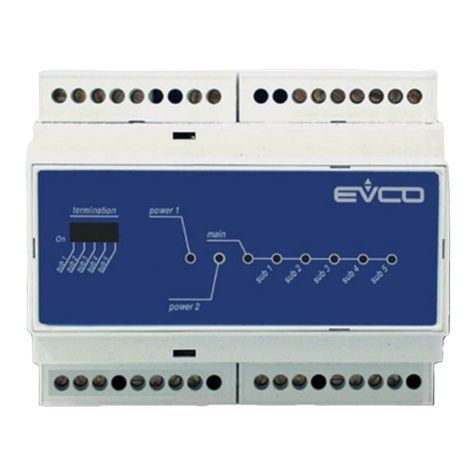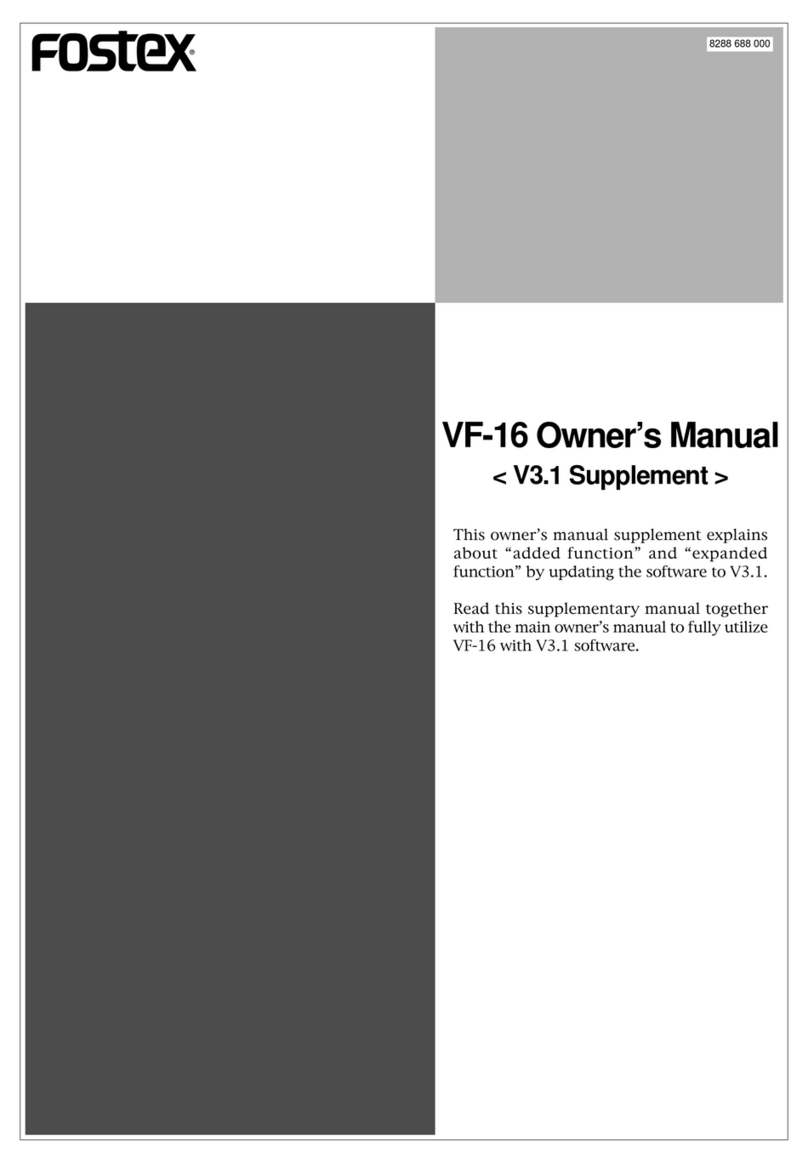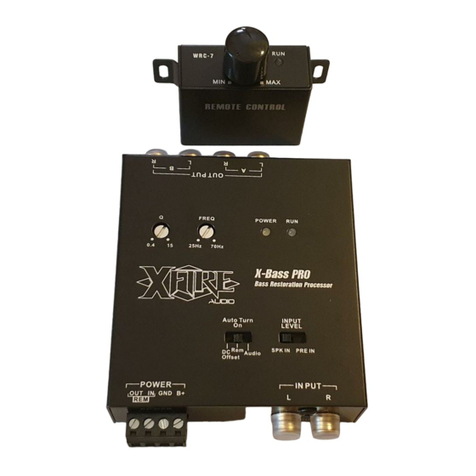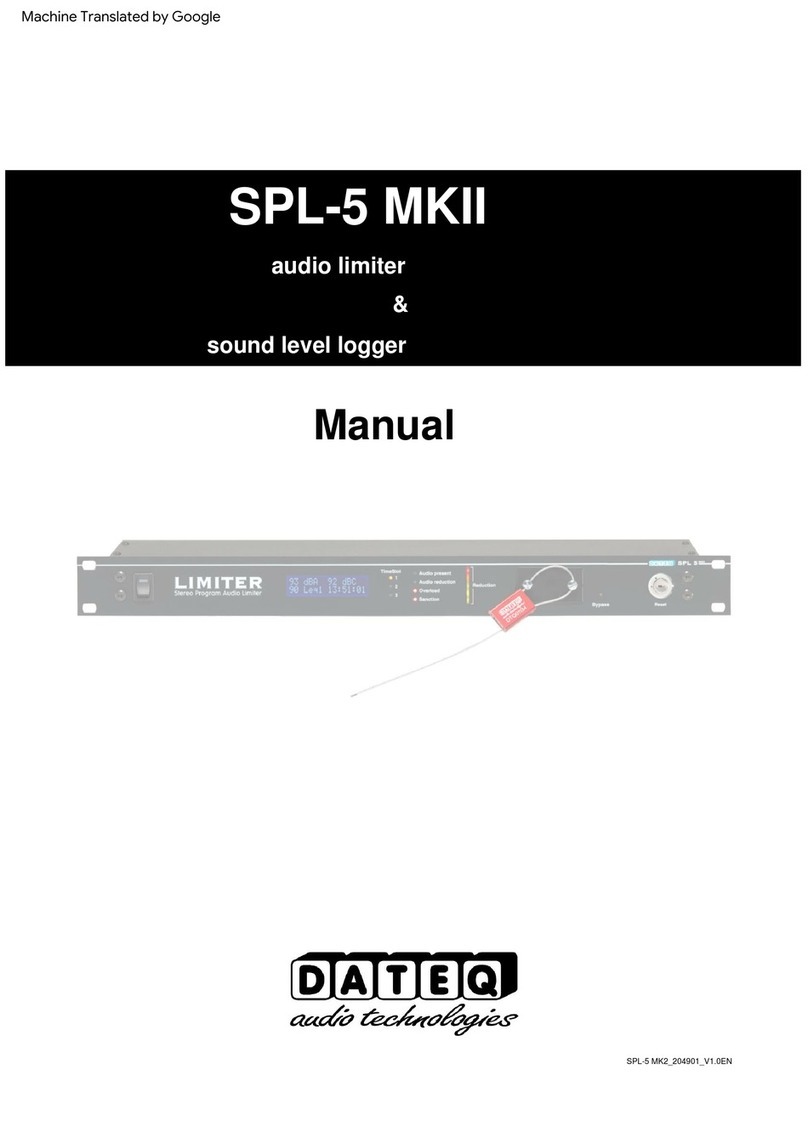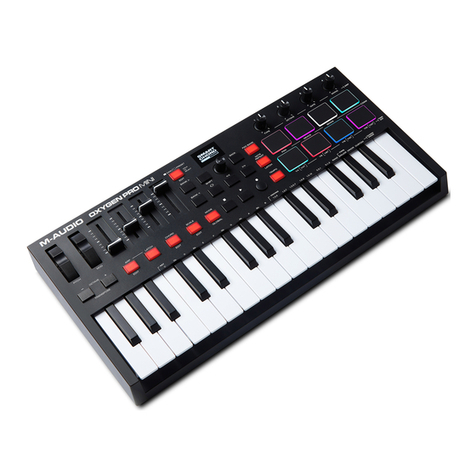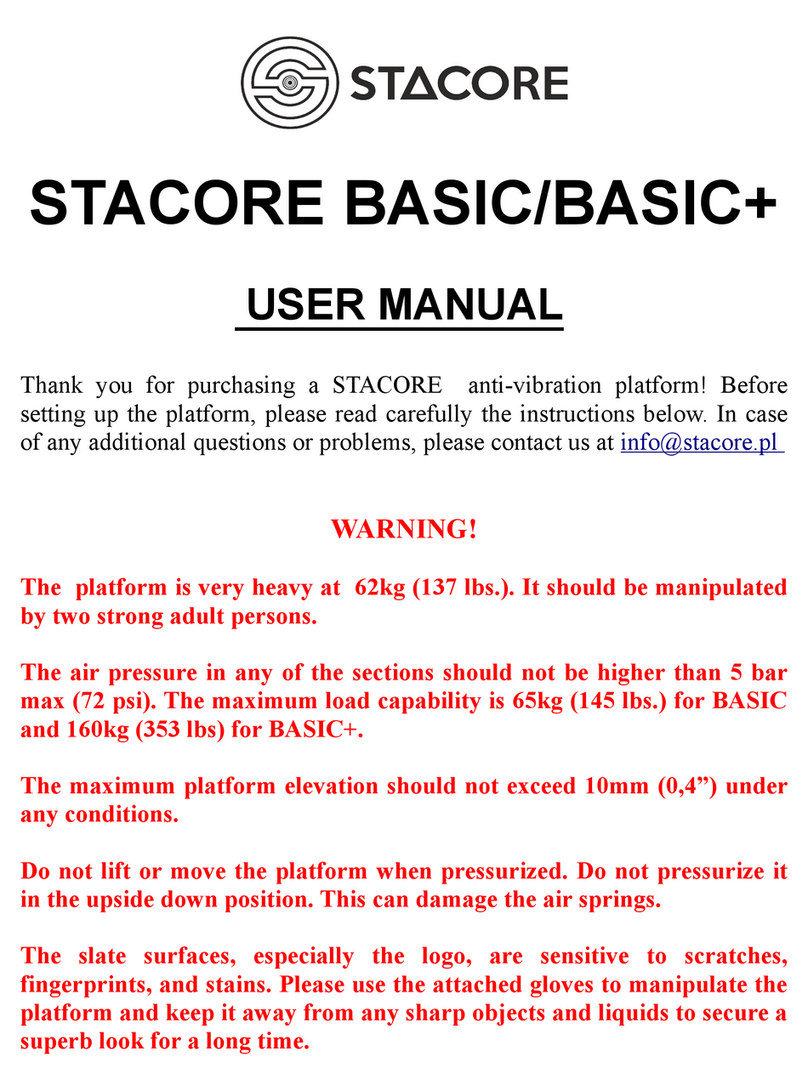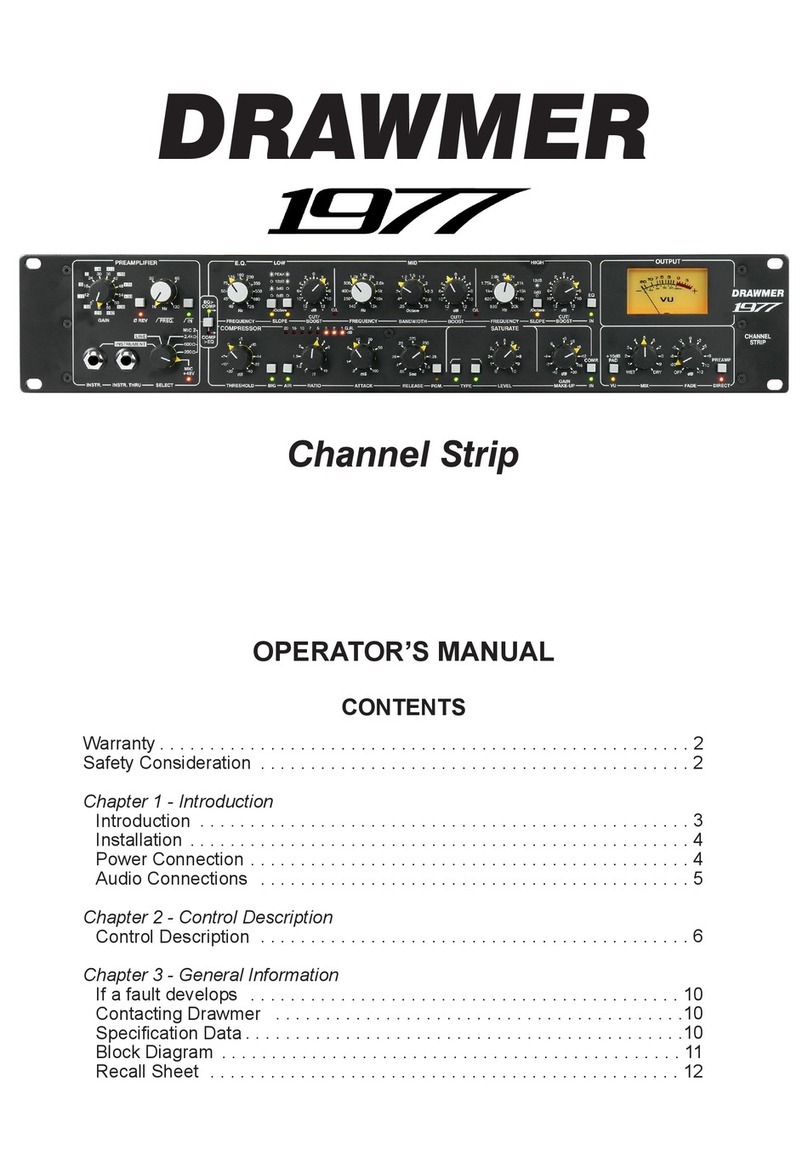Brainworx Ampeg SVT-VR User manual

PLUGIN MANUAL |Ampeg SVT-VR

Ampeg SVT-VR Physically Modeled Bass Amp, Speaker Simulation and FX Rack
Developed under license by Brainworx GmbH Germany for Plugin Alliance LLC USA.
Contents
Introduction 3
The Basics 4
THE BASICS 4
The Amp Section 5
AMPLIFIER SECTION 5
FX RACK Dynamics 6
NOISE GATE 6
AMP FILTERS (switchable pre/post) 6
FX RACK Input 7
INPUT GAIN 7
INTERNAL POWER SOAK 7
FX RACK Rec Chain 8
REC CHAINS 8
REC CHAINS (cont.) 9
The Toolbars 10
PLUGIN SETTINGS TOOLBAR 10
FACTORY PRESETS 10

Introduction |Ampeg SVT-VR
INTRODUCTION:
The Ampeg SVT has been pounding bass player’s chests and audience’s booties for
four decades. The classic tone of the SVT has made it the standard by which all bass
amps are judged.
The Ampeg SVT-VR plug-in is simplicity itself. With just a handful of easily identiable
gain and tone controls, it’s easy to get a great tone ranging from super clean, to
blooming to full on crunchy.
By working directly with Ampeg, Brainworx has produced an exacting plug-in emulation
of this amazing amp, adding to their growing collection of classic bass amps for
Universal Audio’s UAD platform. The SVT-VR plug-in with Unison preamp technology
faithfully provides the legendary fat, smooth and hearty sound that bassists and re-
cording professionals have grown to depend on.
In the FX Rack view you can access a noise gate, 23 world-class Recording Chains and
a power amp simulation including an onboard power soak.
Played through a real bass cabinet (via a standard studio power amp) this plug-in rocks
like the real thing. This is certainly not your average amp sim.
The Main Applications for this Plug-in Are:
1. Recording DI bass into the SVT-VR using Apollo’s Hi-Z input with Unison technology,
then editing and processing them in the DAW completely.
2. Recording hardware preamps through the power amp simulation and Recording
Chains.
3. Practicing at home with minimal latency (in Apollo’s Console, for example), via your
studio speakers, a home stereo system, headphones or a real bass guitar amp and
cabinet.
4. Playing live via a real power amp and speaker setup.
5. Playing LIVE, plugged straight into a live console and / or an in-ear system.
6. Re-Amp less than perfect DI bass guitar tracks, previously recorded with other bass
amp simulations.
3

The Basics |Ampeg SVT-VR
THE BASICS:
You can use the amp section of this plug-in exactly like you would operate the real
Ampeg SVT-VR tube amplier.
Plug in your bass guitar (via your computer audio interface in this case), adjust Gain,
Tone and Volume... and Rock’n’Roll!
Unison Technology
The Ampeg plug-in was developed with the Apollo series interfaces in mind and made
com- patible with Unison preamp technology. Of course the SVT-VR will work with any
UAD-2 device, but to experience ultra-low latency along with important impedance,
gain ‘sweet spots’, and circuit behaviors of the real amp, you need an Apollo interface.
In order to do this, you should insert the SVT-VR in the preamp insert position of
Apollo’s Console application. This will greatly enhance your experience, making the
tone and behavior of your sound an exacting replication of a physical bass amp.
The Ampeg plug-in was developed with the Apollo series interfaces in mind. Of course
the SVT-VR will work with any UAD-2 device, but to experience the ultra-low latency
(desirable for playing in real-time) you need an Apollo interface.
A good producer’s trick is to use a real bass amp (a small combo, for example) for
real-time monitoring in the control room during tracking while recording only the DI
bass signal. Then use the Ampeg plug-in when you play back the recorded tracks
together with the rest of your music. You will need to split the dry bass signal so it
can be recorded in the computer and routed to the real bass guitar amplier input at
the same time.
To play and record dry DI bass tracks with the lowest latency and the highest quality
possible, connect your bass to the Hi-Z Input of the Apollo interface or connect a
quality DI Box and Mic Preamp to a line input of your Apollo Series interface.
If you insert the SVT-VR plug-in in the Console software mixer (to use the plug-in with
the lowest possible latency) you have to decide whether you want to record processed
bass guitar amp sounds (click the INSERT EFFECTS switch to REC in the Apollo
console) or whether you only want to record the dry DI bass signal, while monitoring
the processed amp sound during tracking, of course (click the INSERT EFFECTS switch
to MON in the Apollo console).
The advantage of only monitoring the processed sound is that you can alter the settings
of your amp and FX completely during mixdown. If you nd out later that less or more
Gain would sound better for your song you can still make that happen.
The advantage of recording pre-processed bass tracks might be that you will need
fewer plug-ins during mixdown, as your bass tracks will be ready to be mixed. All you
can do then is EQ and compress the recorded bass tracks, or add eects, just like you
would with traditional bass guitar amp recordings. Once you know ‘your sound’ you
may even save some time by recording processed bass tracks and using them without
further tweaking or ddling around... your band mates
or your producer may even appreciate this. ;-)
4

The Amp Section | Ampeg SVT-VR
5
AMPLIFIER SECTION:
CHANNEL & NORMAL/BRIGHT SELECTION: To select the SVT-VR channel you would like to
use, in either bright or normal mode, click on one of the four jacks. Use the two jacks
in the lower row to select either channel one or two in Normal mode and use the two
jacks in the upper row to select either channel one or two in Bright mode.
VOLUME (CHANNEL ONE): Use this control to adjust the output level of channel one.
TREBLE (CHANNEL ONE): Use this to adjust the high frequency level of channel one. This
provides up to 12 dB of boost, or 12 dB of cut at 4 kHz. The high frequency output is
at at the center position.
MIDRANGE (CHANNEL ONE): Use this to adjust the midrange frequency level of channel
one. This provides up to 20 dB of boost, or 20 dB of cut at the selected frequency.
BASS (CHANNEL ONE): Use this to adjust the low frequency level of channel one. This
provides up to 12 dB of boost, or 12 dB of cut at 40 Hz. The low frequency output is
at at the center position.
ULTRA-HI (CHANNEL ONE): This switch, when engaged [right side down], enhances the
amount of high frequency output of channel one. The amount of boost is dependent
on the setting of the volume control.
1-2-3 (CHANNEL ONE): This switch selects the frequency that will be aected by the
midrange control. The available frequencies are 220 Hz (left side of the switch engaged),
800 Hz (switch in the center position), or 3 kHz (right side of the switch engaged).
BASS-CUT/OFF/ULTRA-LO (CHANNEL ONE): Engaging the left side of this switch decreases
the low frequency output of channel one. Engaging the right side of this switch enhances
the low frequency output of channel one. The switch is inactive in the center position.
VOLUME (CHANNEL TWO): Use this control to adjust the output level of channel two.
TREBLE (CHANNEL TWO): Use this to adjust the high frequency level of channel two. This
provides up to 12 dB of boost, or 12 dB of cut at 4 kHz. The high frequency output is at
at the center position.
BASS (CHANNEL TWO): Use this to adjust the low frequency level of channel two. This
provides up to 12 dB of boost, or 12 dB of cut at 40 Hz. The low frequency output is
at at the center position.
ULTRA-HI (CHANNEL TWO): This switch, when engaged [right side down], enhances the
amount of high frequency output of channel two. The amount of boost is dependent
on the setting of the volume control.
ULTRA-LO (CHANNEL TWO): This switch, when engaged [right side down], enhances the
low frequency output of channel two.
POWER SWITCH: Use this switch to engage or bypass the plug-in.

FX RACK Dynamics |
Ampeg SVT-VR
6
(1) NOISE GATE:
‘CLOSED’ LED:
When lit this LED indicates that the Noise Gate is CLOSED. This means the THRESHOLD
setting is higher than the incoming bass signal and the noise gate dims the output
signal of the amplier by the amount adjusted with the RANGE control (e.g. 15dB in
the picture above).
NOISEGATEON/OFF: Enable or disable the Noise Gate completely. Switch up (‘on’) means
the Noise Gate is activated.
THRESHOLD: The Noise Gate will dim the output signal of the amplier as soon as the
input signal (your bass signal) falls below a certain level. This level is called Threshold.
Adjust the Threshold so the noise of the overdriven amp will be reduced, but make
sure you don´t cut fading notes or chords.
RANGE: The output level of your amplier will be reduced or muted when the input
signal is lower than the Threshold setting. You may dim the output level only by a few
decibels (dB), or completely mute the output in pauses by setting the RANGE to its
maximum.
(2) AMP FILTERS (switchable pre/post)
TIGHT FILTER: With the TIGHT lter you can cut LOW frequencies of either the DI bass
signal (PRE) or the processed amp output (POST).
PRE: If your pickups produce an unintentional rumbling bass sound you can lter the low
end before the DI sound even hits the amplier.
POST:If you want to cut some of the low end of your amplier setting (maybe even only
temporary) you can use this studio quality high pass lter to reduce the bass.
OFF: When set to OFF the TIGHT lter is in bypass mode.
SMOOTH FILTER: With the SMOOTH lter you can cut HIGH frequencies of either the DI
bass signal (PRE) or the processed amp output (POST).
PRE: If your pickups catch a lot of hiss or noise you can lter the high end before the DI
sound even hits the amplier.
POST: If you want to cut some of the high end of your amplier setting (maybe even
only temporary) you can use this studio quality low pass lter to reduce treble.
OFF: When set to OFF the SMOOTH lter is in bypass mode.

7
FX RACK Input | Ampeg SVT-VR
(3) INPUT GAIN:
If you want to drive the input of the Ampeg preamp harder or softer you may adjust
the input gain to your liking. Some single coil pickups from older or vintage basses may
deliver low level output that can be compensated with the INPUT GAIN.
The opposite goes for a lot of heavy metal style humbuckers. If you have recorded the
DI signal too hot or if you are using other plug-ins before entering the Ampeg amp
plug-in you may want to dim the input signal.
With most standard bass guitars you can and should leave the INPUT GAIN at 0 (zero)
though.
INTERNAL POWER SOAK:
In the real world, power soaks are being used to reduce the volume of a bass power
amp. This way you can crank up a (tube) power amp to drive it until it starts clipping,
and still record at a volume which will protect your hearing and keep the neighbors
friendly.
A clipping tube power amp adds distortion and harmonics to the bass amp signal. A
fully cranked up tube amp tamed in volume with a power soak will sound dierent than
the same amp with the master volume turned down.
We have modeled the behavior of the Ampeg power amp, so you may experiment with
dierent settings of the Master Volume of the amp and the internal POWER SOAK.
We recommend a setting of roughly -10dB for most scenarios.

8
FX RACK Rec Chain |Ampeg SVT-VR
(4)REC CHAINS:
Simply select a speaker and a complete studio setup by browsing through the REC
CHAINS pull-down menu!
In the past two decades Brainworx owner Dirk Ulrich has produced and recorded with
members of DREAM THEATER, TOTO, MICHAEL JACKSON, and with many more
famous and infamous acts. The Brainworx Studio in Germany (www.brainworx- studio.
de) is equipped with one of only nine NEVE VXS 72 consoles ever made, and it also
hosts some of the nest outboard EQs and mic pre-amps available.
Using this impressive setup Dirk has produced a huge variety of customized ‘Recording
Chains’ for the Ampegs ampliers, which you can apply to your plug-in amp settings.
Imagine a selection of 26 perfectly mic’d and EQ-ed cabinets that you can select and
use instantly with a single mouse click!
Many bass guitar amp simulations give you some captured impulses of a selection of
cabinets and microphones, then they leave it up to you to EQ and further process these
incomplete setups by mixing dierent microphone setups, adjusting phase and EQ,
and so on. But this really is not an easy job; it takes years of experience to get it right.
Now all you have to do is select the Recording Chain that sounds best for your amp
channel and setting, adjust the Tone Stack and Gain and you´re good to go! Recallable,
reliable, exible and fast.
And if for any reason you should not like any of the Recording Chains the plug-in
oers, you may use the very last setting (labeled CABINET BYPASS) and use your own
mic’d cabinet. This setting will give you the sound of a tube amp wired straight into a
console, which also may be a nice eects sound.

9
FX RACK Rec Chain |Ampeg SVT-VR
(4)REC CHAINS (cont.):
+/- SWITCHES (PLUS / MINUS)
Browse through the REC CHAINS by either using the pull-down menu of the REC
CHAIN text box (see above) or just click through the settings using the + and - symbols.
AUTO & BAR selection:
If you are trying to nd the best sounding REC CHAIN for your actual song it can be
tiring having to play a few chords, then grabbing the mouse to select the next REC
CHAIN, playing a few notes again, grabbing the mouse again, etc.
For this reason the Ampeg amp plugin offers you the AUTO mode:
Just select a pattern (1 Bar, 2 Bars or 4 Bars) and the plug-in will activate the available
REC CHAINS automation, following the actual tempo setting of your DAW. You can
now play uninterrupted and simply listen to the sound of the various REC CHAINS as
the plug-in switches through all of them every single bar, every two bars or every four
bars, depending on your setting.
As soon as you hear the speaker setup you like best just stop AUTO mode by clicking
the AUTO button again and manually select the desired REC CHAIN. Afterwards, just
ne-tweak the TONE STACK and GAIN and there you are.
HORN on/off:
The Ampeg SVT-3PRO’s matching 8x10 speaker cabinet included a piezo horn which
contributed that classic attack tone. We’ve created a separate impulse response for
the horn and added this on/o switch so the sound of the horn can not only be added
to the impulse responses of the 8x10 cabinet, but any of the provided cabinets
whether the original had the horn or not.

PLUGIN SETTINGS TOOLBAR:
BYPASS: Bypasses processing done by the Ampeg SVT-VR
UNDO/REDO (arrows): You can undo and redo changes you made to the controls of the
Ampeg plug-in at any time. The undo / redo will work for as many as 32 steps. This makes
experimenting and tweaking knobs easy. If you don´t like what you did... just undo it.
SETTINGS A / B / C / D: The Ampeg amp plug-in oers four internal settings (A/B/C/D)
that will be stored with every preset. So, one preset can contain up to 4 amp and eects
settings. The settings can be automated (!) in most DAW hosts. This way it´s possible to
switch from a clean picked sound to a grungy slapped sound, for example.
COPY/PASTE / RESET A: To set up variations of similar sounds you don´t have to dial in all the
parameters several times. Let´s say you like your setting A and want to use the same sound, just
with less Tube Gain, as SETTING B:
Simply press COPY while you are in SETTING A.
Switch to SETTING B by pressing ‘B’ in the SETTINGS section.
Press PASTE, now SETTING B is identical to SETTING A.
Reduce the Tube Gain. Done.
Now you can switch between A & B to hear the dierent avors of tone you have created.
FX RACK: Toggle between FX Rack and Standard view.
ABOUT: Information about the development of the plugin.
FACTORY PRESETS:
These presets are only intended to give you an easy start and to demo some of the
tones you can get out of the Ampeg amp plug-in.
CREATING YOUR OWN SOUNDS & PRESETS: When you start to create your own sounds the
most important elements to adjust are the DRIVE, TONE SECTION and the REC CHAINS.
Dial in as much GAIN or Distortion as you like.
Play through as many REC CHAINS as you like and pick the one that sounds closest to what
you are looking for without altering the TONE SECTION.
NOW start tweaking the TONE SECTION to ne-tune your amp settings.
Experiment, be creative. We are condent that the numerous presets and huge selection
of REC CHAINS will oer you many possible combinations that will sound great on a big
variety of musical styles and genres.
Combine the Ampeg amp with other plug-ins (dynamics, eects, room simulation), and
you will be able to create countless world-class production-ready bass sounds in the box.
Enjoy.
THE TOOLBARS|Ampeg SVT-VR
10
Table of contents
Other Brainworx Recording Equipment manuals

Brainworx
Brainworx Engl E765 Retro Tube User manual
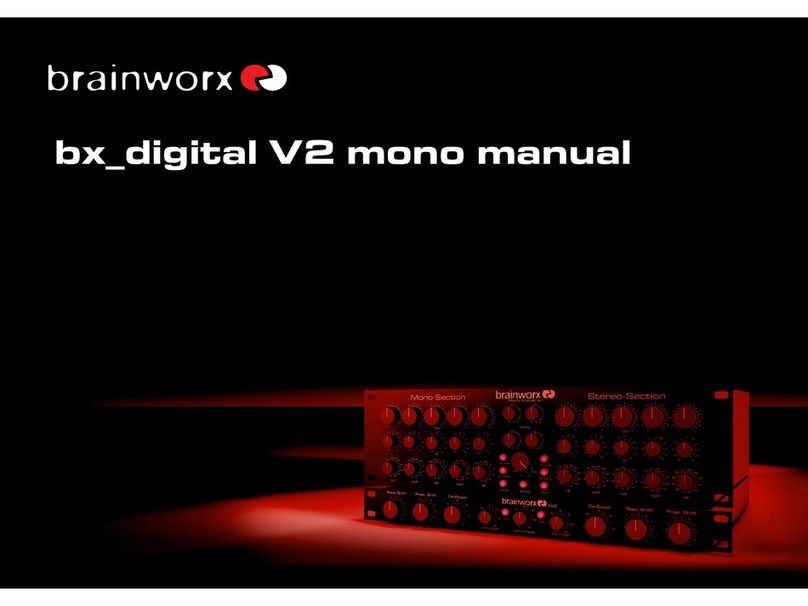
Brainworx
Brainworx bx_digital V2 mono User manual
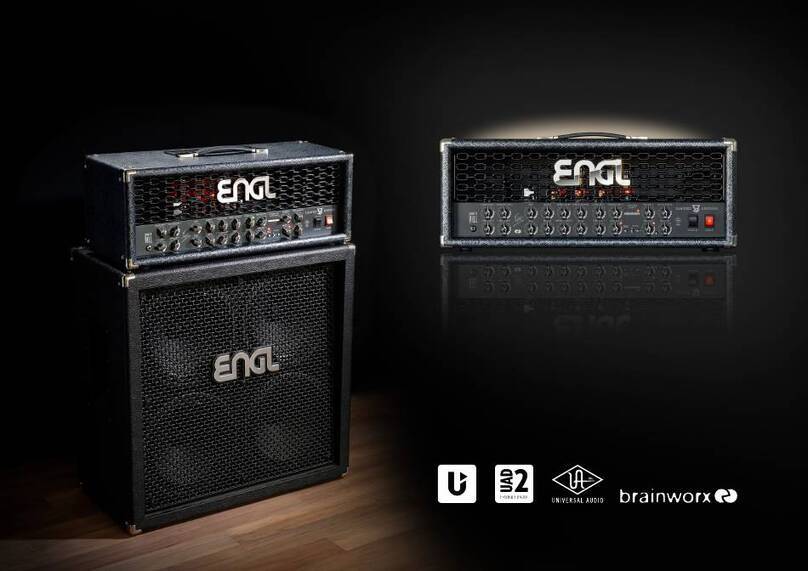
Brainworx
Brainworx Engl E646 VS User manual

Brainworx
Brainworx Gallien Krueger 800RB User manual
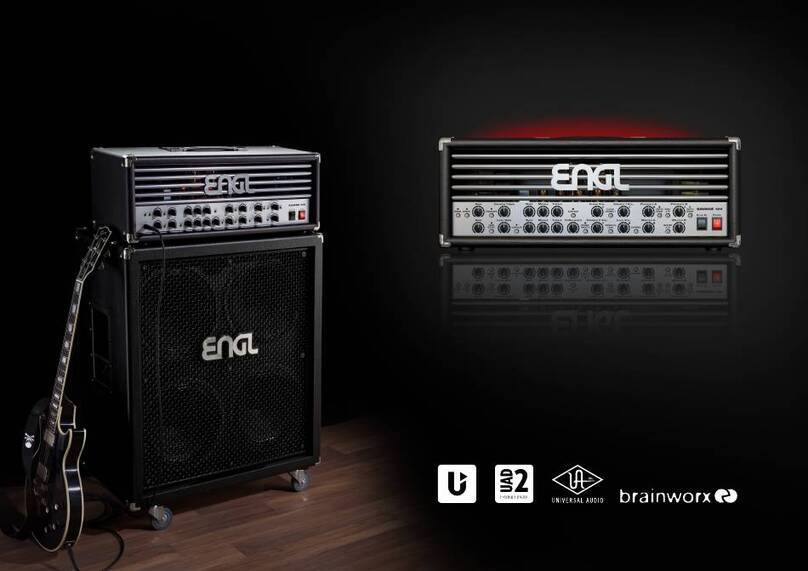
Brainworx
Brainworx Engl Savage 120 User manual
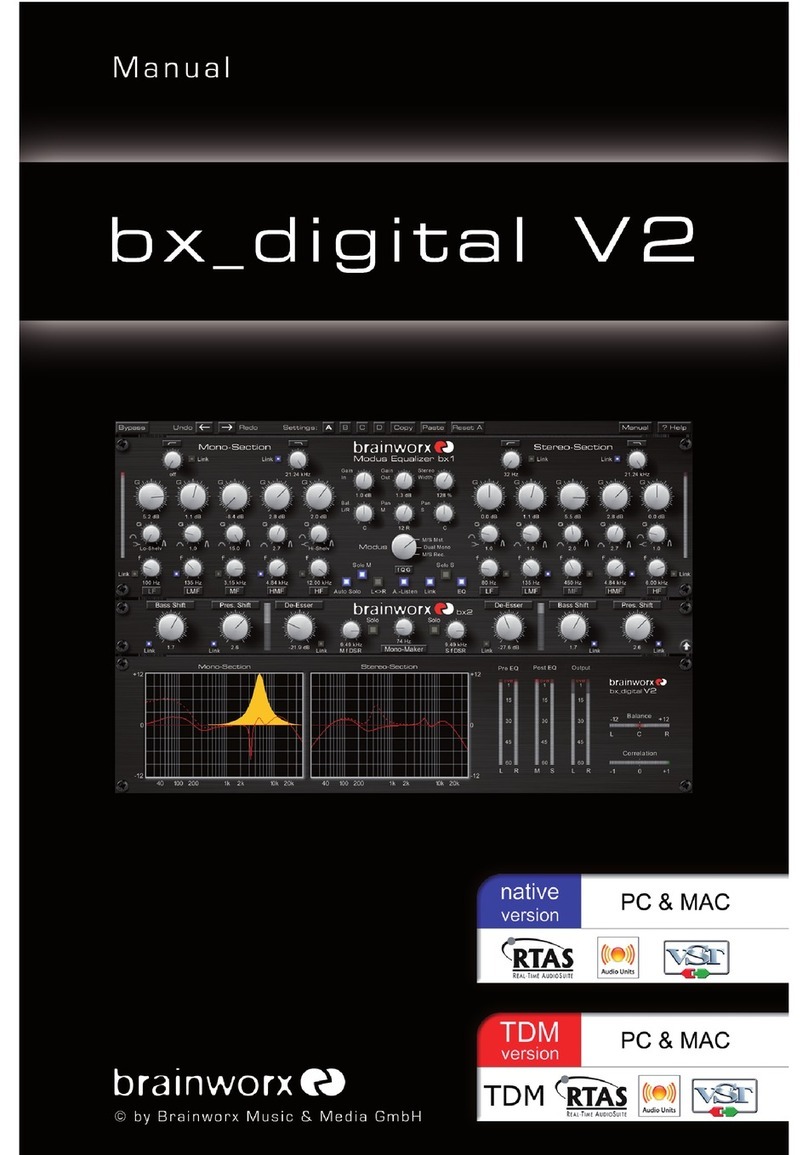
Brainworx
Brainworx bx_digital V2 User manual
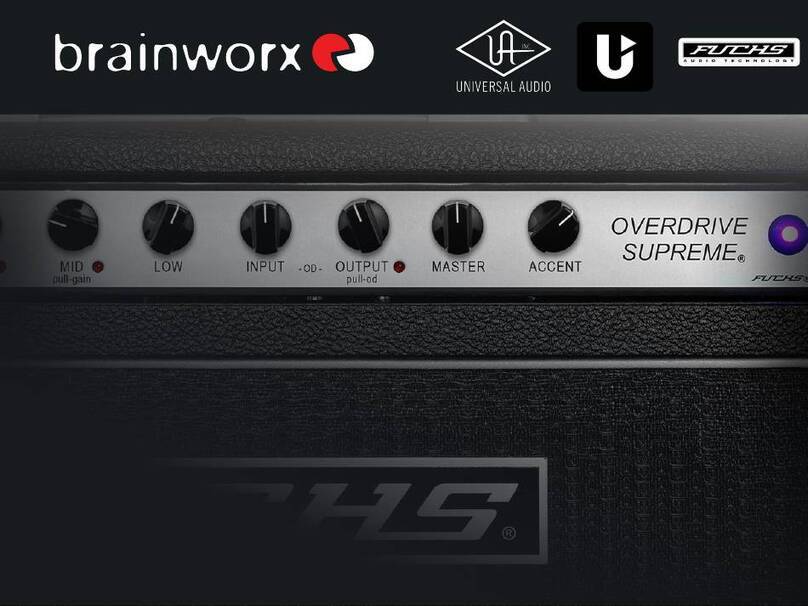
Brainworx
Brainworx Fuchs Overdrive Supreme User manual
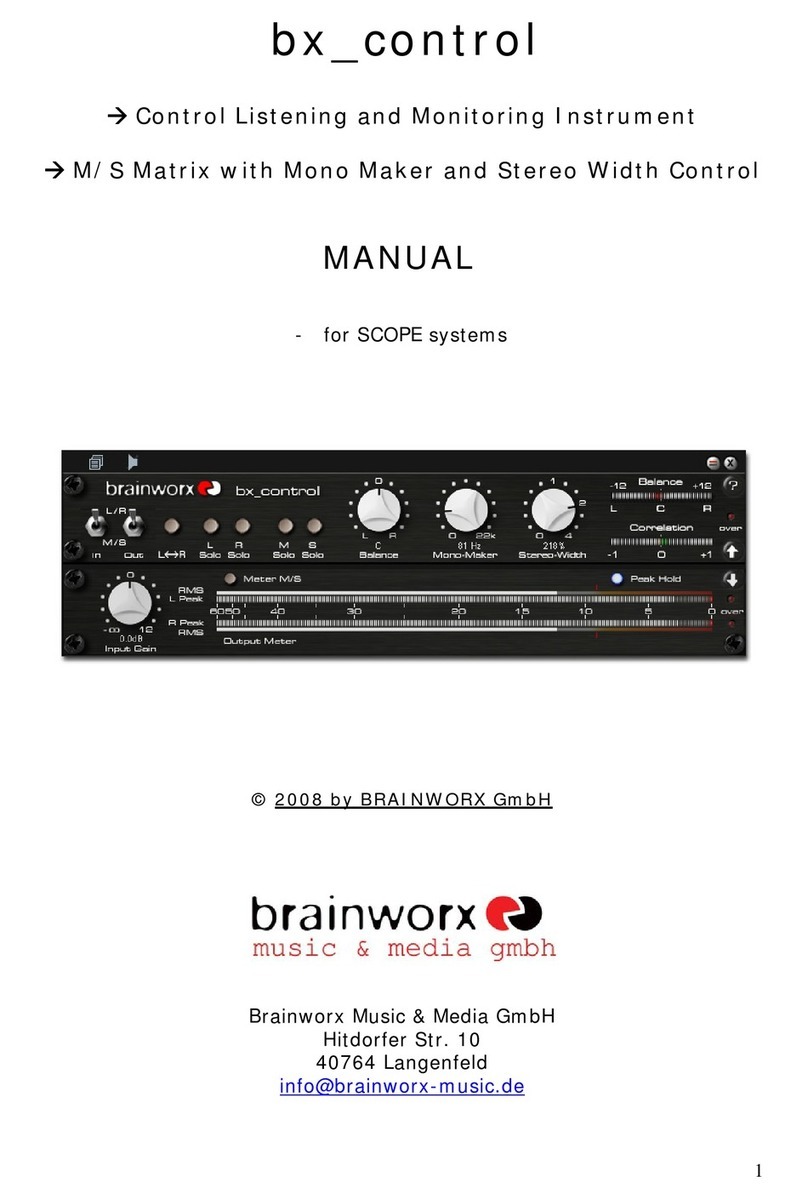
Brainworx
Brainworx bx_control Assembly instructions

Brainworx
Brainworx A/DA Flanger User manual
